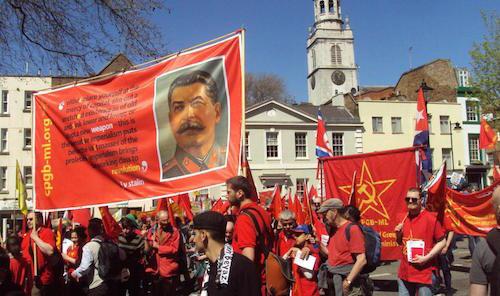May Day’s Communist and Socialist Roots

By Olivia Grady
On May 1, 2017, groups of people gathered on the streets to celebrate May Day.
But these weren’t people who had come to dance around a maypole with flowers or crown the Queen of May to celebrate the beginning of summer. These people were traditionally violent labor activists, celebrating a different kind of day.
This day to them was International Workers’ Day.
In 1889, Raymond Lavigne suggested at the first congress of the Second International, a socialist and labor party in France, that the Haymarket Affair in Chicago should be commemorated with international demonstrations.
The Haymarket Affair was a labor demonstration that took place at Haymarket Square in Chicago, Illinois on May 4, 1887. Workers were striking for an eight-hour workday and against the killings of workers by the police. Unfortunately, someone threw a dynamite bomb at the police who were at the strike. The result was the death of seven police officers and four civilians after the police fired back. Many were wounded.
On the next day, May 5th, the state militia killed seven strikers in Milwaukee, Wisconsin, including a young boy and a bystander.
After Lavigne’s suggestion, the Second International’s Second Congress in 1891 formally recognized May Day as an annual event. This led to the May Day riots of 1894. They were violent demonstrations in Cleveland, Ohio following an unemployment rate increase during the Panic of 1893. The Panic of 1893 was a serious economic depression in the United States.
Finally, in 1904 the International Socialist Congress, the sixth congress of the Second International, which was held in Amsterdam, called on:
“all Social Democratic Party organisations and trade unions of all countries to demonstrate energetically on the First of May for the legal establishment of the 8-hour day, for the class demands of the proletariat, and for universal peace."
Recently, May Day has been expanded to include communist and anarchist groups, and it is celebrated in China, North Korea, Cuba and the former Soviet Union, typically with workforce parades. During the Cold War, top leaders of the Kremlin even attended the large military parades in Red Square.
In the United States, liberal politicians have shown support for these marches. For example, Senator Bernie Sanders from Vermont organized a May Day march last year. This year, Senator Patty Murray of Washington state tweeted:
“I stand w/ people marching to make their voices heard & who refuse to stay silent in the face of injustice & economic inequality.”
May Day has also been expanded to include not just workers’ rights, but also immigrants’ rights, LGBT awareness and police misconduct.
But yesterday, it was all about President Trump, specifically his immigration policies. As one organizer said:
“There’s a real galvanization of all the groups this year,” said Fernanda Durand of CASA in Action, which will lead a march of about 10,000 people for immigrants' rights through downtown Washington. “Our presence in this country is being questioned by Donald Trump. We are tired of being demonized and scapegoated. We’ve had enough.”
CASA in Action is a nonprofit organization that purportedly helps Latinos and immigrants. Not surprisingly, some of its donors include unions.
Unions have been some of the major participants in these protests for a while. You can see their work by looking at their twitter feed, celebrating May Day. They also planned protests. SEIU Local 2015, for example, which represents California Long Term Care workers, planned one of these protests:
“On May 1, International Workers’ Day, people across the country will Rise Up! to resist President Trump’s mass deportation forces and oppose the current administration’s scapegoating of immigrant and refugee communities and their attempts to dismantle programs that benefit working families.
As one of the largest and most diverse long term care union’s in the country, the fearless caregivers of SEIU Local 2015 will turnout to May Day activities throughout the state of California.”
Richard Trumka, President of the AFL-CIO, also published a blog post on May 1st about May Day and immigration:
“Throughout North America and globally, May 1 is a day to remember and respect workers’ rights as human rights. As working people take to the streets in communities around the world, a quieter but equally important movement of workers on both sides of the United States–Mexico border has been growing.”
In the end, thousands of protesters participated in demonstrations around the world. Some protest locations include New York, Paris, Havana, St. Petersburg, Moscow, Istanbul and Tbilisi (Georgia).
There was, not surprisingly, violence. In Paris, for example, six police officers were hurt by 150 masked people throwing Molotov cocktails and stones. Some of these officers were badly burned. In Portland, Oregon, 25 violent protesters were arrested.
How sad that American union leaders look approvingly on a day marked by thuggery and violence in the name of 'workers' rights.'





